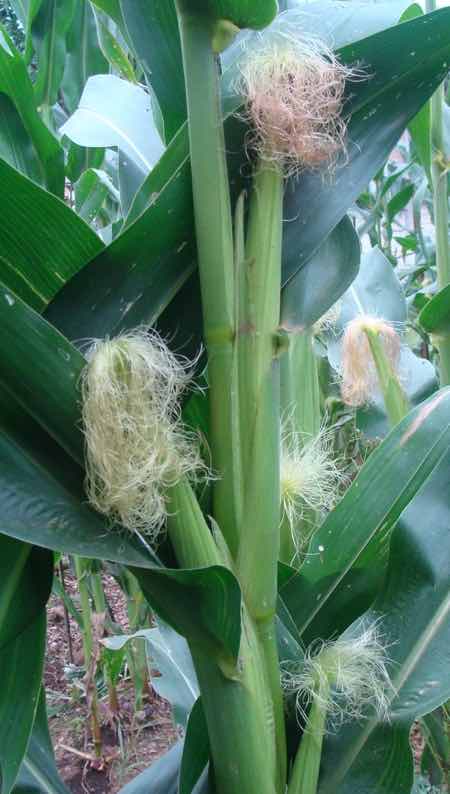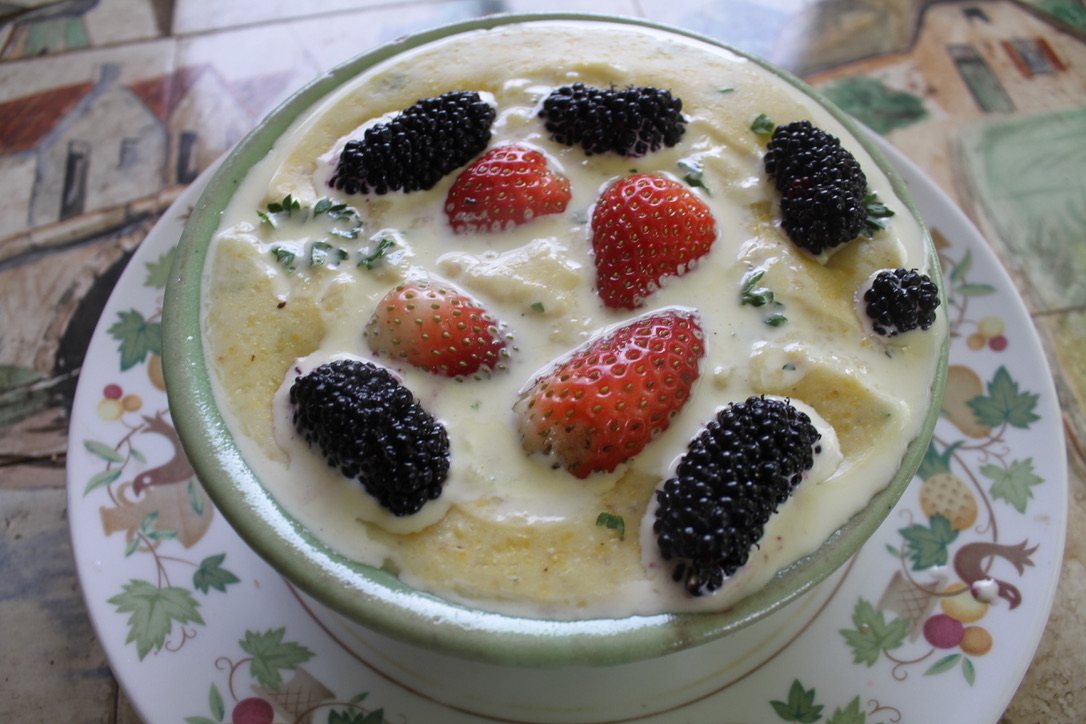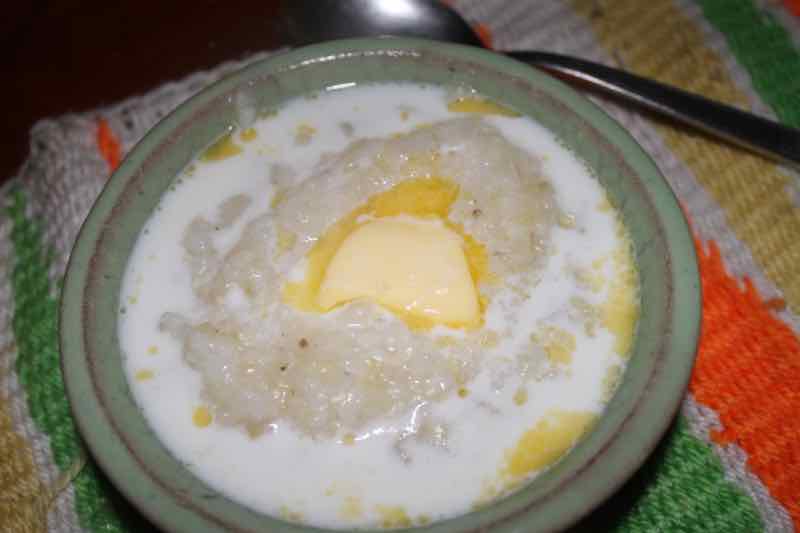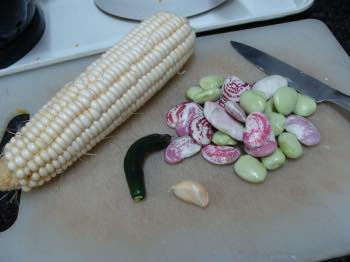- Bernard Preston homepage
- Starch
- Corn in Flower
Corn in flower
Corn in flower is a beauty to behold and should never become blase. This is one of the largest sources of food on planet Earth.
This is a view we just love; corn on the cob every day for three months awaits just around the corner. And hopefully succotash too, if the lima beans will ripen in time; they have a very long growing-season.

This page was last updated by Bernard Preston on 9th March, 2023.
It feeds a lot of farmyard animals and many humans too; this maize-meal porridge is divine and marvelously nutritious if you can get 100% stone ground cornflour.
Oddly I prefer other varieties to sweet corn; those like Border-King that have less sugars.
Midsummer means corn in flower; it is one of the highlights of our gardening-programme.
 Cheesy stone-ground grits.
Cheesy stone-ground grits.Corn or maize as we call it, is in some disrepute as a food high in
starch, allegedly fattening and to be avoided, but we love it. Nixtemalisation is a whole new subject I am looking into; it's the way the ancients in the Americas prepared it, reportedly with greater nutritional benefits.
In the context of wholesome food, I never put on weight even after months of enjoying corn on the cob every day. It is the refined carbohydrates like white-bread, pasta and rice that make me fat. Then the sugar, cakes and cookies add their bit of course.
Desiring to live to a healthy ripe old age and frightened of the side effects of medicines, I have given them up for ever; and lost 10kg in the process.
Highly refined maize-meal, a staple in South Africa, is the chief reason why obesity reigns in our land. It is corn's equivalent of cake flour.
Would you feed your children cake for breakfast? Then a porridge made from highly-refined cornmeal makes no sense at all; it's little different after you have added a tablespoon of sugar. You have set them well on their way to diabetes.
Type-2 Diabetes
Twelve percent of South Africans are now diabetic, one of the highest in
the world. Worse, over half are walking the streets undiagnosed. Seriously raised
blood-glucose is hugely problematic; something approaching a quarter of the nation.
If you suspect you are insulin-resistant, then it is a good idea to test your blood sugar thirty minutes and one hour after a meal of corn; it is a simple, inexpensive finger prick if you know someone with a glucometer. The HbA1c is far more reliable but comes at a cost.
Over ten-percent of the West is now diabetic, so there must be someone with a glucometer around the corner.
Elsewhere in the world it is mostly refined wheat flour and sugar that are the causes of so much suffering. We saw it everyday at the clinic in the Netherlands; painful hips, knees and feet from obesity. Folk suffering from polymyalgia are commonplace too. If you are having a love-affair with crackers, chocolate cake and bagels, then beware.
At the medic's office it means high blood pressure, coronary-artery disease and diabetes; jointly known as metabolic syndrome.
Refined starches are what keep us quacks in business. Cut out the cakeflour, cornmeal and strictly limit sugar; you will be astonished how much stronger you will feel, less painful joints and have more energy.
Brown rice too is a wonderful food; polish it to remove the bran and you have a starch with a GI over 100.
So we unashamedly enjoy our corn on the cob; and low GI bread.
Today, the end of the second week in January we enjoyed our first four-cobs; it has been a long time since I planted the seed in spring but so worth the wait.
And now two-months later, we are half way through the crop; there is little sign of fall army-worm thanks to the hens. They too get three or four cobs a day; and we enjoy eggs with bright orange yolks.
Losing our sight
There are twin epidemics currently in the world that are growing at frightening rates; nearsightedness in children and adult-onset macular degeneration. Diet is profoundly important; so is time out of doors.
So too is "visual hygiene." That should include taking a break every thirty minutes whilst reading and during screen time; what are known as "near work." Maintaining a proper distance whilst reading and using cellphones is important; so is good lighting.
So is spending more time out of doors. Bright light stimulates the release of dopamine from the retina which helps prevent elongation of the eye, a major cause of myopia, or nearsightedness.
Both wholegrain corn, rich in lutein and zeaxanthin, and broad and lima beans, the only common sources of L-dopa contribute enormously to the health of the eyes.
Corn in flower
Corn in flower boggles the mind; each of those tassels ends in just one pip. In the summer garden you can see a shower of pollen raining down on those stamens. It is all about fertilisation.
I have enjoyed watching several different species of birds, most commonly the weavers, feasting on the pollen this summer.
They help with the pollination by spreading it far and wide.
Corn like most vegetables, the exception being the butternut family, loses its flavour very quickly after being reaped.
Old corn is deadly dull, and nutritionally far less protective against disease; but straight from the summer garden to the pot, it is one of the highlights of every lunch in our green home. Like sourdough bread we never tire of it.
Be assured, 100 percent wholewheat bread and fresh corn on the cob, if you can get them, are not the cause of obesity. Learn about the meaning of the term glycemic index, and apply it to your meals; then you can delete that dirty four-letter word "diet" from your vocabulary. It is the refined starches that do the damage.
Interestingly folk living in the five Blue Zones of the world, where vigorous old age is the norm, never go on diet and nor do they step out and exercise; they have so ordered their lives that there is no need.
Drop your cobs into a little boiling water, cover with a lid and turn up the heat; they will be done in about five minutes. When you can smell them, then they are cooked. We keep that liquid that remains after steaming for use in soups and gravies; and for making stone ground grits.

According to Harvard, the glycemic index of sweet corn on the cob is only 48. That is low; it is not fattening. Our white maize will be even less.
Surprisingly adding a little butter lowers the glycemic index further, and makes it even less fattening. Lipids in our food also contribute to the absorption of important phytonutrients.
Once you see corn in flower, it will be only a few weeks until you can start to enjoy this excellent food as often as you like; a true wholegrain.
It is particularly rich in a phytochemical called zeaxanthin that is needed in very high concentration in the macula of the eye; together with the lutein in dark green leafy vegetables, it will prevent you from getting macular degeneration, the leading cause of adult-onset blindness.
Enjoy the fruit of your corn in flower. It is very wholesome; and delicious provided it is picked young and cooked within a few hours. It is our ambition to eat a mealie a day for much of the summer; with zero terror of it adding to our waistlines.
We prefer to cook it within fifteen minutes of reaping the cobs.
One does not need a vegetable garden trellis for corn; the plants are very well anchored in the ground. However we like to grow climbing beans and limas near our maize for the nitrogen they fix in the soil.
Corn and beans are a staple. Growing limas means we can enjoy succotash every year. I like to toss in a jalapeno or peppadew to spice it up a bit.
This is our quick succotash recipe.
For more about the details of the nutrition of 100% cornmeal read this page[1].
As for little old me, I'll stick to the magnificent mealie cob.

Summertime is when we have carbs galore; luckily none of them are glycemic yet we still try not to over-indulge. Too much starch at a meal is never a good thing.
When browsing use right click and "Open Link in New Tab" or you may get a bad gateway signal.
Newsletter
Our newsletter is entitled "create a cyan zone" at your home, preserving both yourself and Mother Earth for future generations; and the family too, of course. We promise not to spam you with daily emails promoting various products. You may get an occasional nudge to buy one of my books.
Here are the back issues.
- Lifestyle and ideal body weight
- What are ultra-processed foods?
- Investing in long-term health
- Diseases from plastic exposure
- Intensive lifestyle management for obesity has limited value
- A world largely devoid of Parkinson's Disease
- The impact of friendly bacteria in the tum on the prevention of cancer
- There's a hole in the bucket
- Everyone is talking about weight loss drugs
- Pull the sweet tooth
- If you suffer from heartburn plant a susu
- Refined maize meal and stunting
- Should agriculture and industry get priority for water and electricity?
- Nature is calling
- Mill your own flour
- Bake your own sourdough bread
- Microplastics from our water
- Alternative types of water storage
- Wear your clothes out
- Comfort foods
- Create a bee-friendly environment
- Go to bed slightly hungry
- Keep bees
- Blue zone folk are religious
- Reduce plastic waste
- Family is important
- What can go in compost?
- Grow broad beans for longevity
- Harvest and store sunshine
- Blue zone exercise
- Harvest and store your rainwater
- Create a cyan zone at your home
Did you find this page interesting? How about forwarding it to a friendly book or food junkie? Better still, a social media tick would help.
- Bernard Preston homepage
- Starch
- Corn in Flower
Address:
56 Groenekloof Rd,
Hilton, KZN
South Africa
Website:
https://www.bernard-preston.com